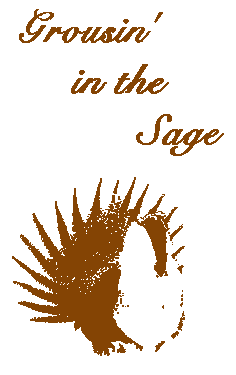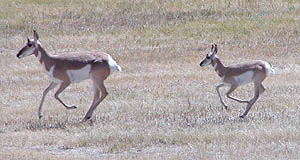






powered by SignMyGuestbook.com

| Newest
Older Previous Next Random Contact Profile Host |
blizzard warnings - 13:52 , 03 October 2013 heelerless - 21:32 , 18 August 2013 Red Coat Inn in Fort McLeod - 11:38 , 23 June 2013 rushing into the waters - 09:53 , 21 June 2013 choosing a spot - 17:43 , 27 April 2013 |
antelope numbers
So, the wardens and I classified 9,521 antelope last summer. Over nine and a half thousand antelope looked at to determine if they were a doe, fawn, mature buck or yearling buck. One hundred and eighty-two more than we classified the year before. In nine different management areas. Most by pickup and spotting scope, some from the air.
Over all, 52 fawns for every 100 does. Fawn production up in five of the nine areas. Some substantially. Down substantially in a couple others. Lots of variation, with ratios that ranged from 28:100 up to 72:100.
72:100 is good to see. Barring any other problems, a herd with that kind of production should grow fairly fast.
28:100 may not even make up for natural losses.
Ratios of yearling bucks to does were also quite wide, ranging from 9:100 to 36:100. The 36:100 is just incredible. Assuming there's a yearling doe out there for every yearling buck, then almost every single one of the 2001 fawns in that area must have survived their first winter.
On paper, anyway. In reality, it usually means a bunch of antelope moved into that area in the previous winter. And when the does and their daughters left in spring, moving back to their normal summer ranges, the lazy new yearling bucks looked around and said "This'll do." And stayed.
Ratios of mature, harvestable bucks ranged from 30:100 to 54:100. From respectable to pretty good. No sign that any areas are being overharvested.
Overall buck:doe ratios ranged from a moderate 43:100 to an insanely high 86:100 (the area where all the extra yearlings showed up). That high number suggests there are plenty of extra bucks in that area that hunters could enjoy this coming fall. (Although, remembering the sage advise I received from an old biologist when I first got here. There are two ways of getting a high buck:doe ratio. First is to have lots and lots of bucks. The second is to shoot too many of the does. Always have to watch out for the second.)
Only three of the areas are supposed to be managed to have buck:doe ratios above 60.
None of those three did.
But ratios beat 60:100 in three other areas.
I see we need to move some hunting licenses around this fall.
